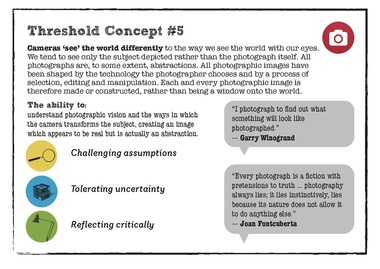

With this photo, the shell is obviously the main focus as the colour contrast of a black background and the pinks and oranges of the shell and its position immediately draws the eye to the centre. However, Peter Fraser has captured an image which almost perfectly shows the shell in a specific light, yet the detail behind is lost by the dark colours in contrast with the subject.
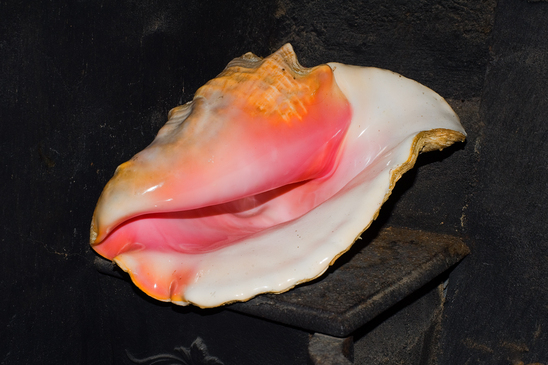
We also looked at Peter Fraser's Green Shed, and analysed in depth his image following the questions given. I discovered that the formal elements played a large role in the analysis, and the image held a lot of contrasts within the rigid lines compared to the softer more detailed and intricate lines of the grass. Also, we discussed how the photographer may have taken the photo to highlight the natural aspects of the trees, grass and shrubbery with the artificial rigidness of the metal shed.
Looking at the relationship between the shed and the text, I thought that the text had been written by someone other than the photographer and Peter Fraser was simply interested in the irony of the text compared with the dominant colour of green within the photo.
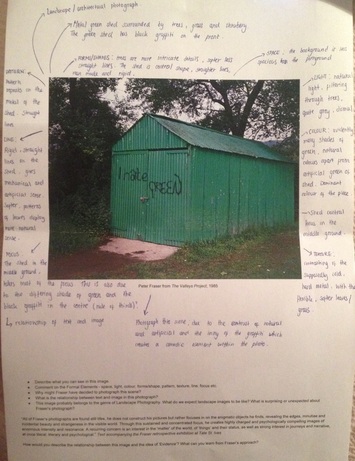
The exhibition Mirrors and Windows, an exhibition of American photography since 1960, opened at The Museum of Modern Art, New York in July of 1978. The curator John Szarkowski’s attempted to categorise photographers whose work largely reflected the subjectivity of the artist in comparison with those whose work largely sought to see outside themselves.
Inspired by this exhibition, we looked at a range of photos and thought about where we should place them on the spectrum.
"The distance between them (the art work) is to be measured not in terms of the relative force or originality of their work, but in terms of their conceptions of what a photograph is: is it a mirror, reflecting a portrait of the artist who made it, or a window, through which one might better know the world?" -John Szarkowski
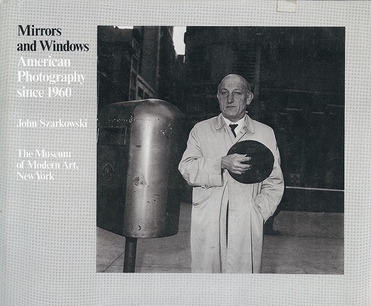











Below is the order I decided to place the images in from mirrors to windows. I discovered throughout this task, that most if not all photos fit into this scale and can range from completely mirror-like, such as subjective and psychological, all the way to a window type photo, such as objective, real and public.
I have decided to now record specific aspects of the traces I leave behind, and focus more intently on my unmade bed each morning. I will document this for a week or continuously through until I feel I have a selection of photos I can work with. I will hopefully include them in my final piece as a certain aspect of images on a timeline involving human evidence. I photographed whichever bed I slept in that night, and over the course of a few days I realised that I was more intrigued with the creases made rather than the whole state of the bed. This is an even more intricate aspect of evidence, as I am focusing on the specific folds and lines which are almost impossible to not leave behind after sleeping within a bed.





















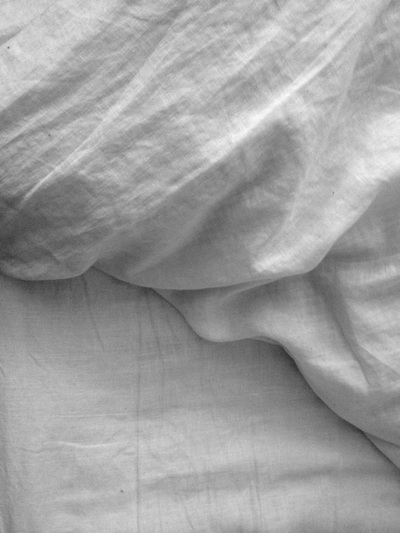









I discovered during the week, that specific angles to capture the bed at proved to be slightly challenging. Not only because of the angle of how the bed was positioned, but the main subject of the photo was more obscured, not necessarily for the viewer but for me as well. I had to think of many ways of how to capture either the whole bed or specific sections. As the week progressed I decided to focus more intently on the creases the sheets produced. However, I felt the more photos I took the more intimate the series was becoming, and gave me a sense of uneasiness, despite this I continued with the series. A bed is one of the most common household objects that we all assume everyone has, yet when photographed there is a sense of intimacy and privacy that is broken and shared between the photographer and the viewer. I had no idea this was how I would feel until after the series had been taken, however although it is a feeling of discomfort, it intrigued me and I felt that I had accomplished a bigger task than I had initially set out to do.
If I concealed the actual bed, does it take more of the intimacy out of it? or do the close up of the creases add intimacy? Now I've examined the bed itself for the conceptual side to really flourish I want to look at the people that sleep within the beds and how their own skin fits with the creases thy leave. To do this, I want to obscure any kind of identification, therefore I want the person to be facing away whilst I capture their indentations/lines/wrinkles on their back.
The conceptual idea, is that of capturing all the different intricate lines and patterns left by people on their beds and vise versa, each person will have different patterns depending on how and where they sleep. This helps to analyse how complex the idea of evidence can be and on such a small-scale.
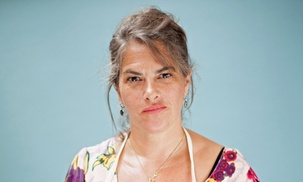
Born 1963 in London, known for her controversial and provocative work.
As inspiration and further research into "Evidence", I have decided to examine how I can include all the different types of evidence into my work. At first, I took Tracey Emin's "My Bed" following on from my own bed series. This is a personal view or intake into the artist's life, where there is still room for interpretation and privacy, whereas her other work "Everyone I Have Ever Slept With" is a different form of evidence. It is a more forward and public view of evidence, although personal to the artist, she has herself decided to publicise her privacy in a way which produces evidence about herself and others.


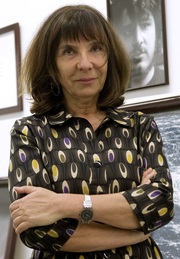
Sophie Calle born in 1953, is a French writer, photographer and conceptual artist. Calle's work is usually recognised and shown to frequently depict human vulnerability, and focuses on identity and intimacy. She is recognised for her work following strangers and investigate their private lives and her work "Talking to Strangers", in which she asked strangers to sleep in her bed and allow her to photograph them. Sophie Calle completed her first artwork in 1979, inviting forty-five friends, neighbours and strangers to sleep in her bed. She documented these encounters with photographs and text. The Sleeper (1979) is the first link in a chain of other works including The Shadow (1981), The Blind (1986), the latter considered to be Calle's most controversial work, and her 1999 video collaboration Double Blind , produced with Greg Sheppard (the film version of No Sex Last Night ). Her photographic work often includes panels of text of her own writing and is sometimes thought of as controversial.
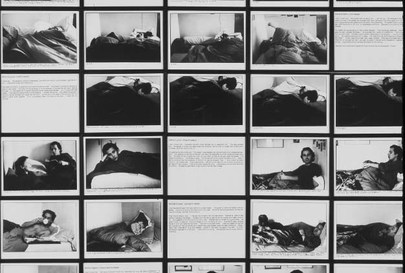
Sophie Calle takes a conceptual approach when photographing her bed, as the idea behind it shows more focus on the prospect of strangers experiencing and sleeping within her bad, rather than the actual detail of the photographs themselves.
I think with influence from Sophie Calle, I have decided to progress my work in a more conceptual way, rather than focus intently on the photographs themselves, as the meaning behind my photographic work should be recognised just as much, if not even more so than the photographs.
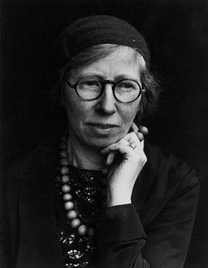
Imogen Cunningham was born in Portland, Oregon in 1883, she was an American photographer known for her botanical photography, nudes, and industrial landscapes. Cunningham was a member of the California-based Group f/64, known for its dedication to the sharp-focus rendition of simple subjects. In 1932, Cunningham co-founded the Group f/64, which was named for a large-format camera’s smallest aperture setting. The group which aimed to "define photography as an art form by a simple and direct presentation through purely photographic methods."
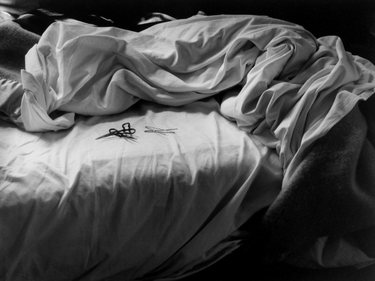
In comparison to Sophie Calle, Imogen Cunningham takes a more aesthetic approach and appreciates the beauty, folds and detail of the subject. To me, it appears as though she has captured the creases and folds of the sheets to look like a body sleeping on the bed. I feel that my work of the creases in my bed series relates more to Imogen's quality of the photograph, as the attention to detail and use of black and white (much in the same way as both Calle and Cunningham's work) helps to emphasis and highlight the contrast of the folds and reflects how the light falls on to the sheets.
After a deeper analysis into Sophie Calle's work, it has inspired me to look at her works, "Hotel" (1984) and "Talking to Strangers", as both incorporate a typology-style work which I feel could work with my unmade bed series as well. Typologies had their main roots with August Sander's series of portraits in 1929, titled "Face Of Our Time". I feel that typologies in themselves are related to 'evidence' as each photo shows a different face of humanity and reveals how humans are evidence of progression and age within the world. A series can be a continuous document of a specific subject, which is what I want to try and achieve with my unmade bed series.
Group f/64 was a group of seven 20th-century San Francisco photographers who shared a common photographic style characterised by sharp-focused and carefully framed images seen through a particularly Western viewpoint. Their name stems from the small camera aperture and a large depth of field which was how their photos were created. Group f/64 was created when photographer Willard Van Dyke and Ansel Adams decided to organise some of their fellow photographers for the purposes of promoting a common aesthetic principle. Other photographers in the group include; Ansel Adams, Imogen Cunningham, John Paul Edwards, Sonya Noskowiak, Henry Swift, Willard Van Dyke and Edward Weston.
After looking at only specific ways to document 'evidence', I decided to go back to basics and create a mind map of all the things evidence could mean or be linked to. Throughout the mind map, more ideas could be produced and I discovered how broad the idea of 'evidence' actually is; I particularly liked the new idea of evidence on scales from reliable-unreliable, or how abstract or natural is the photo? Does this prove good or not so good for evidence? Or even evidence of progression within the world, such as changes in architecture, cars, fashion and the electronic world.
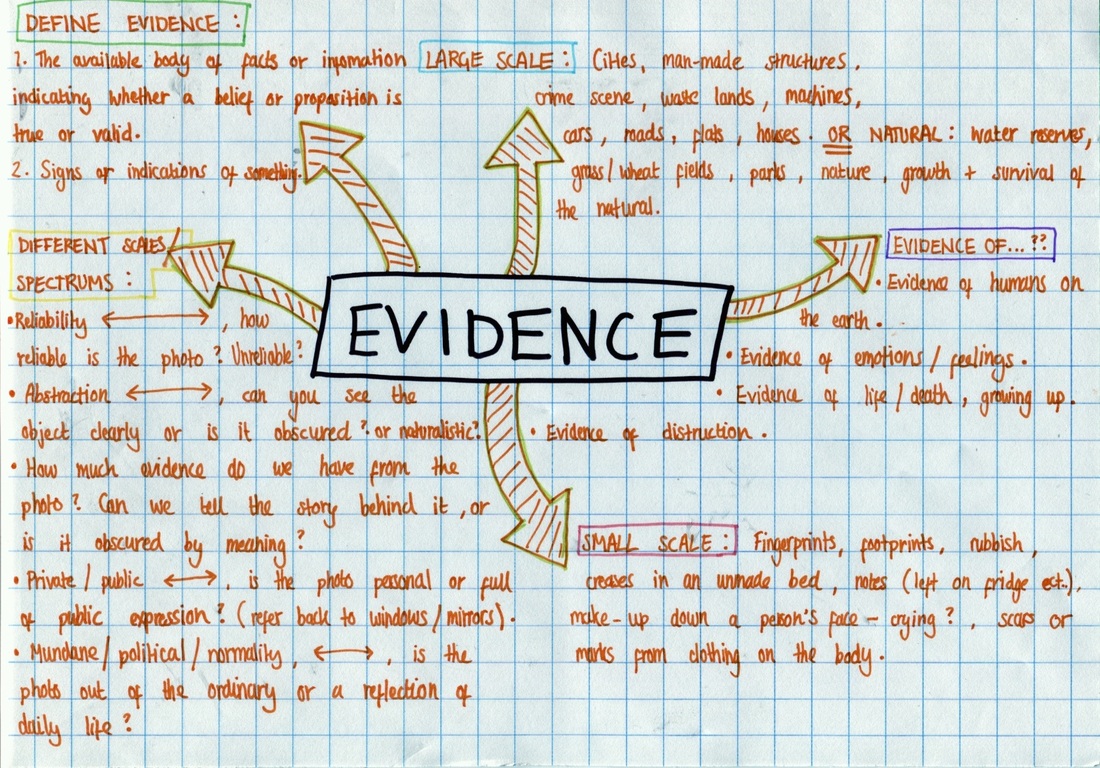
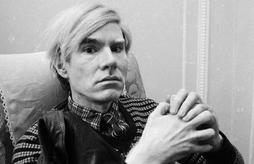
"The best thing about a picture is that it never changes, even when the people in it do." -Andy Warhol
Born on August 6 1928 in Pennsylvania, originally named 'Andrew Warhola', Andy Warhol was a successful magazine and ad illustrator who became a leading artist of the 1960's Pop art movements. In 1949, he moved to New York and changed his name to Warhol as he ventured into a wide variety of art forms, including performance art, film making, video installations and writing. He is most renown for his pop art of Marilyn Monroe and also other famous celebrity portraits including, Elizabeth Taylor, Mick Jagger and Mao Zedong. As these portraits gained fame and notoriety, Warhol began to receive hundreds of commissions for portraits from socialites and celebrities. He was also known for his pop paintings of Coca-cola bottles, vacuum cleaners and hamburgers, which could be read as a critique of what he viewed as a culture obsessed with money and celebrity, or on the other hand, Warhol's focus on consumer goods and pop-culture icons, as well as his own taste for money and fame, suggest a life in celebration of the very aspects of American culture that his work criticized.
The above quote links to my work in unit 2, as my photos very much depict an element of a person's characteristic, as the creases or way people sleep may suggest or show the viewer of the photo an insight of a vulnerable side of the subject. Although the photo is frozen in time from when it was taken, a series of images can show changes or progression within something over a period of time, much like a typology which is what I am currently investigating. Warhol's quote could possibly mean that photography has the ability to depict a specific moment in time, and forever hold the same meaning to it even when in reality the situation or subject has changed; in a way the world of photography has its own reality.
To help further add to the conceptual idea of demonstrating the small-scale impact of evidence, I have taken photos of the people who's beds I photographed earlier. At the moment they are two separate sets of images, but for a prep piece I will print out specific photos and align each bed corresponding to the person who usually sleeps within the bed.





















Before the final piece I wanted to create a prep piece to see how I could possibly display my images and see if a conceptual or aesthetic approach would be better. I arranged my photos in a variety of ways, seeing if they looked better in a collage form visually (taking a more aesthetic approach) or if I grouped the backs and beds together in such a way that there was a relation between the bed sheets and the person who slept on them (conceptual approach). In the end, I decided to fit two pieces of mount board together and create a more aesthetic approach- I had the backs across the centre as the main focus, and around them I positioned the sheets and beds of which those bodies in the centre had slept on. Within the piece are small visual elements that link the photos. For example, as the last photo shows a curved body and below two photos with a fold in the centre. Here, I tried to let the body capture the way the creases form on the sheets, much like the straight crease down the sheet and a back indentation running down the centre to the far left of the work. These little mimics are only small but conceptually play a large part within my piece.






I think that the simplistic style and look of the piece makes it lean more towards an aesthetic work which I will work into the final piece. I feel that the setting out of the photos worked well as I linked the images in groups of backs and bodies, yet also included the small visual links as I have previously stated. I feel that possibly I could have used a bigger mount board to fit more photos on as I did not get to include as many as I would have liked. Having said this, the lesser amount of images allowed a more simplistic layout which I prefer. I feel that the conceptual idea behind the piece could have been stronger, which is why I will mainly be guided away from that in my final piece. As work to do before the final work, I want to find a more interesting way to display the photographs which give more of an impact.
For the final piece, I will chose just two of the photos I have photographed of backs and bed sheets and print them to an A0 size to give a big impact and enhance the conceptual idea of the skin and sheets matching. I have chosen the photos depending on the patterns and lines the skin and body make in comparison to the folds of the bed sheets. There are subtle similarities between the two photos, but this is why I am hoping that the larger prints will give the impact and allow the people viewing the work to have more of a chance to visualize these small elements.
Throughout unit 2 I have investigated a range of photographers who have inspired me each in different ways. This allowed me to incorporate each element of a photographer into my work. I researched Tracy Emin, Sopie Calle and Imogen Cunningham (aside others) and their works on beds- each took a very different approach. I then looked at 'mirrors versus windows' and researched both Sophie Calle and Imogen Cunningham as oppositions of the scale. Firstly, Sophie Calle took more of a conceptual approach to her work, allowing the idea behind her photos to express more than the actual quality of the images themselves. Following this idea I also focused more on the conceptual aspect, deciding to explore the similarities of human skin and the bed sheets the body sleeps on and draw a visual similarity between the two. I wanted the meaning to be just as if not more important than the images, as through research I discovered how each aspect of the final piece incorporates into the work- not just the visual photo. In contrast, Imogen Cunningham's work followed a very aesthetic approach, focusing intently on the quality and appearance of the photo itself. Aesthetic work appreciates the beauty within the photograph which is what I feel I did through my backs and bodies series. I drew attention to the details on the skin such as scratches, bed sheet markings and veins. I feel that the quality of the photos show these 'imperfections' or details and was as equally used and played just as an important role within the process for my final piece. Both conceptual and aesthetic photography has shaped my understanding in a way that now enables me to view photos in different ways. It also helped me to categorise and understand the difference between when photographers are trying to show the quality of their photo, or communicate with the viewer in a certain way to explore or show an expression or opinion on a subject matter. When I was taking photos of my unmade bed, throughout the process I also discovered my own personal investigation. I realised that you do not necessarily need to capture the subject as a whole, and that sometimes capturing just a portion or element can be just as if not more revealing. By this, I mean that the closeness and intimacy of selecting only creases to photograph possibly gave away (in a conceptual way) more about the person than if I was to just photograph the whole bed. It allowed myself, as well as the viewers, to focus on the specific patterns created to enhance the sense of intimacy. This whole thought process occurred when I firstly began photographing just the bed as a whole, trying to give a sense of the environment around the bed. However as the days progressed I found myself drawn into the finer details and began to photograph only the creases. The impact this investigation had on me was definitely positive. I feel that I am now able to select a part of a subject that I intend to photograph and realise what element relates best- not only to the theme but to the people that view the picture as well.
When developing my investigations I was always led by an idea which followed on from the previous one. I wanted to go further into invading privacy, as for me photographing where I slept for a week made me feel quite uncomfortable and felt as though anyone who viewed it was intruding on my privacy. Although being uncomfortable, this sparked an idea and I was prepared to go further to see how close I could go to visually and conceptually into others privacy. This is when I decided to photograph the peoples backs who also slept in the bed or who I shared with over the week. I specifically chose backs as I wanted the identification of the people to be unknown, as the concept of drawing a visible link between back and body was still important to me, as well as the idea that people often sleep on their backs or on their sides. So I began the series of backs, which I really wanted to include more of an aesthetic approach after I focused on more of a conceptual take previously. I focused on lines, indentations, sheet marks, scratches- anything to give away how the person might sleep and details which can only be noticed when stood right next to or exposed though the camera. I found myself incorporating ideas of both Sophie Calle and Imogen Cunningham equally, a good quality photo as well as a good idea were both essential for my work. As my series progressed, I asked the people to move in certain ways mimicking the shapes of the folded sheets I had previously photographed. I used the camera to focus on these visual links and expose in more detail the similarities.
Although initially I was thinking about creating a collage or selection of images, I ended up simply sticking with a very minimal and simplistic way of displaying only two images. This helped to give maximum impact to the quality of the photo and allowed a very simple visual comparison to be made, which I feel was not able to flourish within the prep work I made as there were too many photos overcrowding the piece. Throughout the unit I have used lens based photography and instead of refining through materials, I found myself progressing through the resources of other artists and discovering that the more intimate things I photographed (eg. bed sheets, people's backs) enabled me to create new and more interesting ideas. For me, my ideas behind the work was the driving force and helped me to refine my work by just taking new sets of images and piecing them together by an idea.
For my final piece, I was hoping to create an aesthetically pleasing set of images which showed a visual comparison and also included a conceptual idea which helped to draw links metaphorically as well as visually. I feel that my idea did work, as the final piece are two images blown up to an A0 size which I can display side by side for full impact. My ideas evolved from focusing on small scale evidence of humans, to that of intricate and intimate details left behind. I firstly wanted to gather a selection of images and compare each of them together, yet I found that using only two images gave a bigger impact than a lot more put together. This is because there was less to focus on visually and the individual details on each picture did not get lost within each other. I used the specific grainy effect on the paper because just the same as skin and bed sheets can be both crinkly and imperfect, the paper gives the same effect. Every aspect of the final piece should fit together as one, meaning the skin and beds and the photo itself should blend together to look the same. The paper is folded to again represent the folds and creases of skin. It also gives a sense of closeness as the photos are both zoomed in, the paper acts as the small folds on bed sheets and the lines on people's skin. When unfolding the pictures, it gave me the thought and same motion as unfolding a bed sheet and laying it out for people to see. As said previously, this is because I wanted every single aspect of the piece to be able to link together- not just the photos but the actual paper and physical attributes as well. Materiality played a large role in my work, as the large scale has levels of detail appropriate and relevant to the works physical existence. The large scale, A0 size I feel gives a sense of intimacy, as all the details are focused on and have been captured as a close up. Also, the large size is almost life scale and acts as though you are standing next to or in front of the person in the photo. Although this may feel uncomfortable, I feel that provoking these emotions helps to create an audiences own personal response to the photos. Although I have previously stated that the aesthetic side of the project was just as important, the quality of the photograph does get sightly lost on the large scale. However, this is deliberate as the pixels are suggestive of the closeness of the photo, they are a physical representation of the skin . The pixels reflect how zoomed in on the skin and bed sheets the photo is, and the intent and concentrated features of both images. The piece looks different from far away compared to close up, this is because far away the visual representation is more prominent of the visual line between the sheets and the skin following through both images and is clearer, like looking at a person. From far away you are able to see a person's basic physical structure and features, yet the indentations on their skin are not visible. Whereas close up, the grainy effect enables you to experience the pixels and in a sense 'imperfections' of the printing, just like when you look closer at a person you are able to see more imperfections and details on the skin.
To achieve all this, there were three main stages to my process; first was the bed to the body. The bed was a comparative to where the body sleeps. Second, was the body and the bed emerging as one, acting as representations of each other. Thirdly, the photos themselves were printed to match the content/subject of the photo. The printing process played just as an important role as the actual taking of the photos themselves.
For me, the most important influences has been Sophie Calle and Imogen Cunningham. I liked both their work which enabled me to combine their independent ideas and produce my own conceptual idea with influence from Calle's typology of people sleeping in her bed, with the detail that characterises Cunningham's 'The Unmade Bed'. These two photographers enabled me to be inspired and further create more complex ideas within my mind all from images of their beds. I feel that this work as a whole reflects my interests as a photographer in the way that I believe a meaning or an idea behind a photo gives the image a story which can be told visually and not through words, yet in the same way a photo which was taken simply at the right place at the right time can also be just as effective visually and allows the audience to create their own story or meaning for the image. Bringing both these beliefs together has resulted in my final piece which I feel reflects both the visual and conceptual side to photography. I feel a camera can be used for a spontaneous moment or for a carefully thought out process, and until you take the photo or have the idea, you never know yourself which way it will go.